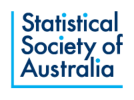Are you an early or mid-career statistician looking for support to grow and develop your career? Or, are you a more experienced statistician looking to share your skills and experience with a new generation of statisticians? If either of these sound like you then this program may be for you!
The Statistical Society of Australia is now seeking applications from mentees and mentors, for the next program intake in 2023. We are looking for up to 20 mentor-mentee pairs to take part in the 6-month mentoring program.
Our aim
This program will connect early and mid-career statisticians to experienced mentors to provide them with career guidance and to share their experiences to help them achieve their professional goals.
Mentees
We are looking to recruit early to mid-career statisticians to take part in the mentoring program. To be eligible to participate, you must be either a student or within the first ten years of a career in statistics, a member of the SSA, and be willing to commit to participating in the program over a 6-month period.
Mentors
We are looking to recruit mentors who have at least five years’ experience working as a statistician. Note that mentors will be paired with mentees with less experience working in statistics (i.e., those with less than five years’ experience will not be paired with mentees with more than five years). To be eligible to participate, you must be a member of the SSA and be willing to commit to participating in the program over a 6-month period. Prior mentorship experience would be beneficial but is not a requirement for participation.
Program details
The SSA Mentoring Committee, a sub-committee of the Continuous Professional Development committee, will match mentors to mentees and contact the mentee to seek approval to introduce them to the proposed mentor. Each mentor will only be assigned one mentee. Mentees are responsible for arranging the initial meeting and establishing ongoing meetings with their mentor. Ideally, mentors and mentees should aim to meet at least monthly for one hour during the program, with a minimum of four meetings over six months. There is no requirement that mentors and mentees live in the same city; meetings do not have to be face-to-face and may be held via phone or Zoom as necessary. A member of the Mentoring Committee will be in touch throughout the program to learn how things are progressing and to help resolve any issues that arise. There is no expectation that the relationship will continue beyond the 6-month program. However, we would be delighted if mentor-mentee pairs continue to keep in touch!
In addition to the paired mentoring, mentees and mentors will be given the opportunity to participate in a peer mentoring group to share experiences and build greater connections within the SSA community.
Further details about the program will be provided before the program commences.
Interested?
To register your interest in participating in the mentoring program, please complete the following form by Sunday 11th December. Successful applicants will be notified by the 20th January (Mentees) and 30th January (Mentors), with training scheduled for the end of February. The program will run for 6 months from March to August 2023.
If you have any questions about the mentoring program, please email the SSA Mentoring Committee.
